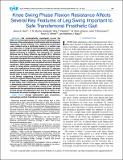| dc.contributor.author | Kent, Jenny A | |
| dc.contributor.author | Arelekatti, VN Murthy | |
| dc.contributor.author | Petelina, Nina T | |
| dc.contributor.author | Johnson, W Brett | |
| dc.contributor.author | Brinkmann, John T | |
| dc.contributor.author | Winter, Amos G | |
| dc.contributor.author | Major, Matthew J | |
| dc.date.accessioned | 2022-01-26T19:33:13Z | |
| dc.date.available | 2022-01-26T19:33:13Z | |
| dc.date.issued | 2021 | |
| dc.identifier.uri | https://hdl.handle.net/1721.1/139755 | |
| dc.description.abstract | We systematically investigate in-vivo the effect of increasing prosthetic knee flexion damping on key features of the swing phase of individuals with transfemoral amputation during walking. Five experienced prosthesis users walked using a prototype device in a motion capture laboratory. A range of interchangeable hydraulic rotary dampers was used to progressively modify swing phase flexion resistance in isolation. Toe clearance (TC; vertical distance toe to floor), effective leg length (ELL; distance hip to toe), and knee flexion angle during swing phase were computed, alongside the sensitivities of vertical toe position to angular displacements at the hip, knee and ankle. Key features of these profiles were compared across 5 damping conditions. With higher damping, knee extension occurred earlier in swing phase, promoting greater symmetry. However, with implications for toe catch, minimum TC reduced, and minimum TC and maximum ELL occurred earlier; temporally closer to mid-swing, when the limb must pass the stance limb. Further, TC became less sensitive to changes in hip flexion, suggesting a lesser ability to control toe clearance without employing proximal or contralateral compensations. There is a trade-off between key features related to gait safety when selecting an appropriate resistance for a mechanical prosthetic knee. In addition to highlighting broader implications surrounding swing phase damping selection for the optimization of mechanical knees, this work reveals design considerations that may be of utility in the formulation of control strategies for computerized devices. | en_US |
| dc.language.iso | en | |
| dc.publisher | Institute of Electrical and Electronics Engineers (IEEE) | en_US |
| dc.relation.isversionof | 10.1109/TNSRE.2021.3082459 | en_US |
| dc.rights | Creative Commons Attribution 4.0 International license | en_US |
| dc.rights.uri | https://creativecommons.org/licenses/by/4.0/ | en_US |
| dc.source | IEEE | en_US |
| dc.title | Knee Swing Phase Flexion Resistance Affects Several Key Features of Leg Swing Important to Safe Transfemoral Prosthetic Gait | en_US |
| dc.type | Article | en_US |
| dc.identifier.citation | Kent, Jenny A, Arelekatti, VN Murthy, Petelina, Nina T, Johnson, W Brett, Brinkmann, John T et al. 2021. "Knee Swing Phase Flexion Resistance Affects Several Key Features of Leg Swing Important to Safe Transfemoral Prosthetic Gait." IEEE Transactions on Neural Systems and Rehabilitation Engineering, 29. | |
| dc.contributor.department | Massachusetts Institute of Technology. Global Engineering and Research Laboratory | |
| dc.contributor.department | Massachusetts Institute of Technology. Department of Mechanical Engineering | |
| dc.relation.journal | IEEE Transactions on Neural Systems and Rehabilitation Engineering | en_US |
| dc.eprint.version | Final published version | en_US |
| dc.type.uri | http://purl.org/eprint/type/JournalArticle | en_US |
| eprint.status | http://purl.org/eprint/status/PeerReviewed | en_US |
| dc.date.updated | 2022-01-26T19:23:41Z | |
| dspace.orderedauthors | Kent, JA; Arelekatti, VNM; Petelina, NT; Johnson, WB; Brinkmann, JT; Winter, AG; Major, MJ | en_US |
| dspace.date.submission | 2022-01-26T19:23:42Z | |
| mit.journal.volume | 29 | en_US |
| mit.license | PUBLISHER_CC | |
| mit.metadata.status | Authority Work and Publication Information Needed | en_US |
